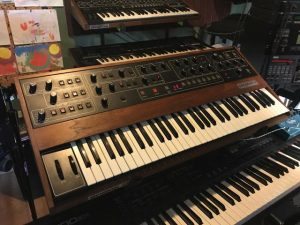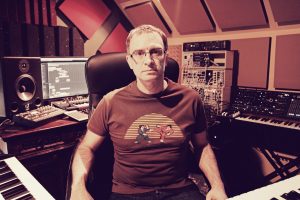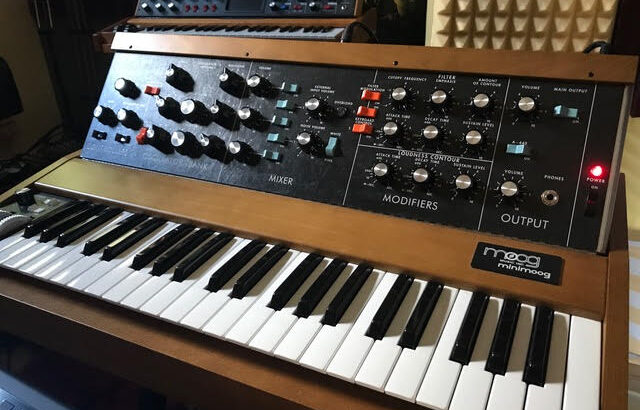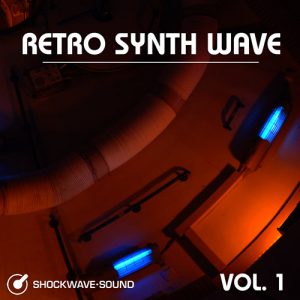I’ve been a big synthesizer music fan from many, many years. It all started when I first heard Jean Michel Jarre album “Oxygene“. Then when I first heard the SID chip from Commodore 64 and tunes from Martin Galway and Rob Hubbard. I felt in love with those sounds, those leads, portamentos, basses. The music on the „Oxygene” was cosmic, was not from this world. It was really great. Until this day, it is like JMJ was getting something out of synthesisers that still sounding really like it was not composed on synths.
And from those times, in 1980’s started my chase for having good sounding real hardware analog synths. But, in 80s it was not so obvious for me. Poland was under communism and all the knowledge about synths was, for the most part, hidden. We didn’t have synth TV commercials or music magazines. Poland was also a poor country. We didn’t have the money to buy expensive synths.
The SID chip in the from Commodore 64 wasn’t enough for me. Now, when CHIP music is very popular, it is not so clear to me. Despite the SID having an original sound, sonically this is a very rudimentary sound in the field of sound quality. It doesn’t have any real warmth or depth. So, I decided to sell my Commodore 64, which I regret until today (I now have another one, but it is not my original) in order to to buy a synth that I could afford. But, it wasn’t really a synth. It was just a keyboard with some basic synth options: a Yamaha PSR36. Today, some people find this keyboard nostalgic. But for me, it was just a sound which I really didn’t like. It was ok, but not professional. Of course, I made a lot of tracks on it with some help from a tape machine, but I really hate Yamaha PSR36 cheesy sound.
Those times I played on a borrowed Roland D-20, which I liked very much, but it was too expensive for me to buy one. Also I played once on a Roland D-50 in a music shop. It was just like being in heaven for couple a seconds. After that, nothing was the same. But, I did buy a Roland D-50 – 30 years later!
My next synth, which I hoped would be better and that I could afford, was a Yamaha DS55, but it wasn’t. The FM sound quality on this synth didn’t sound like a Yamaha DX7, it was only a little better but still sounds plastic. No one heard in late 1980’s about trance or techno basses and I think the DX100 was far better than DS55.
So, I started to look for the next synth, and the next, and the next. A pretty good purchase was a Roland JX-1. It wasn’t an analogue synth, but it sounded pretty good. My first pro synth, in fact, a Rompler workstation, which sounded more professional was the Korg 01WFD. I added to it also a Roland JV880. So it was my first semi-pro sounding pair of synths, not exactly synths, just romplers (A machine that plays back sounds created by pre-recorded samples stored in ROM). I still like romplers till this day, but they weren’t analogue. They weren’t Moog or Prophet quality.
Related: New CD-collection: RETROMANIAC, Vol. 4
My first analog synth was Roland JX8P. I really like it. But editing it was a nightmare, so I relied mostly on the patches and I sold the Roland after a couple of months. Since it was end of 1990’s, my career as video game composer had started, so I was looking also for gear on which I could imitate an orchestra. So, a Roland JV1080 and Akai S3000XL was a better idea for investing my money. Also, I bought a Korg Prophecy and a virtual analog synth which I really loved, the Nord Micro Modular. But my first really good and proper analogue synth which I have until this day was a Waldorf Pulse. I don’t use it very much, but I’m keeping it. I like its power basses, but I don’t really like its filter.
Having a versatile set of hardware for composing music for video games and movies was most important to me, and in the beginning of the new century the analogue sound wasn’t as popular as it is today. In those times you were asked to stay away from 1980’s style music. It was the time when Prodigy, Chemical Brothers and Orbital were on top, so distorted sounding synths were on top too. It was the times of Roland TB303, which I respect, but never quite liked.
I think my nostalgia for going back to 1980s and having real analogue synths started with Dead Island video game. Also, I really loved the first plugins like the Pro-53 from Native Instruments and Minimoog Model D from Arturia. And I really realised that not having a real analog synth, which is/was cult, meant that I was missing something.
But when I composed music for for Dead Island, the nostalgic sound from 80s still wasn’t really mainstream. So the producers didn’t allow me to go back to 1970s / 80s zombie movies which were based on analogue synths and old Emulators, Fairlight. So, Dead Island has the sound of distorted synths paired with orchestra samples. But, on Dead Island Riptide I started to use very heavily the Zebra2 and Diva from U-he, which sounds very similar to Moog, Roland, Korg analog synths, with bunch of plugins from Arturia – mostly Minimoog, Prophet 5 and Arp2600.
For the game Dying Light I decided to go deeper into the 70s/80s zombie movies vibe. But real analog hardware synths were also starting to get really expensive, so I couldn’t afford much really good stuff. Mostly, the soundtrack to Dying Light was composed on XILS plugins, Jupiter 8, CS-80 from Arturia and SH101 plugin, virtual analog or sample based UVI. Also on a couple of synths. My first Moog Sub Phatty and really great machine, great DCO analog synth Elektron Analog Four.
And then came the Prophet 6 and it all began to move faster for me. I just felt in love how good hardware synths sounds and how much I love them. Especially when they are polyphonic. After Prophet 6 was OB6. It was a really great synth. I like them both. My music from this time was more toward Tangerine Dream and Boards of Canada, also still my beloved John Carpenter style in mind. I just feel nostalgic for this era and it looked like everybody else were too. In synth music, the 1980’s were back.
I need to find my own way of course. My first, a cult old analog synth was the Roland Jupiter 6. It is pretty obvious for me now, but from this synth I was really starting to understand what is my way in the synthesiser world. Also, I started to understand one big difference. There are vintage oscillators and modern oscillators. What not all people notice, oscillators are ageing. They start to sound different after some time. Not exactly more detuned, but the difference between Prophet 5 and Prophet 6 is really obvious, and not only because of filters. So, the reissue of synths are always good, but new synths are not sounding the same as old synths.
Also, I started to understand that I don’t need a shop with synths. I don’t need to be a collector, even I wanted to be, because I love it. It is not necessary for having your own sound to keep a lot of synths in my home studio stock.
Before Jupiter 6 I bought Minimoog Model D reissue. And I realised one additional thing. There not only sound can be inspiration. Look of synth can be inspiration too. Having cult synth, cult looking synth just under your fingers is like supermodel which agreed to go to date with you. It is inspiring, touching real knobs, real wood and metal. It is so important for your composing process.
On my bunch of synths I composed my first album „Der Weg”, which I can say it is my own way. Inspired of course by Tangerine Dream, Boards of Canada, Carpenter and Jarre, it is my own way, more dark, very nostalgic and to have a lot of changes. I didn’t like too long arpeggios in music, I can’t stand synth pads which are four minutes long. I need music which is pulsating, which is telling a story, which isn’t boring you. The name was kind of a tribute for german electronic musicians like Kraftwerk and Tangerine Dream, of course. Since John Carpenter was inspired by them too, Jean Michel Jarre too. Also, in the 80’s Germany was kind of a paradise when you go there from our poor Poland. It was what the 80’s should look like, 80s like we almost never have, in Poland it was kind of remains of 80s, not quite real 80s like other world.

So, in 2018 on my vacation on the Baltic Sea I borrowed a Prophet 5. And it was like a thunder blast. I understand. It was this synth which I was always looking for. Dark, detuned, inspirational, very deep sound. With a broken heart I exchanged it for a Jupiter 6 (I hope I’ll be back some time to it, or MKS80, since I don’t want to sell my house to be able to afford a Roland Jupiter 8) and after hearing one great album from artist Maciek Polak, which was made only with an AKS Synthi, I decided to go minimal.
I think I should check myself. I never liked restrictions and I always thought that more synths mean better music. And I first started to think that maybe too many synths does not mean better music, but to rely on only a couple synths will unleash my creativity.
So. Because I really love my Minimoog Model D I came to an idea. Let’s make an album with only two synths. Two cult analogue synths under my fingers. Let’s try, let’s do that.
The first couple of tracks came really easy. The Prophet 5 is so inspirational. Just Prophet and some bass from Moog, and the track was ready, and it’s sound. I really don’t need to use a bunch of plugins to make it sound better. There was just no need for that. Even if I was about to start using too many plugins, the magic somehow started to disappear.
I made this album in three months since my everyday work is to create music for video games, and mostly I’m doing this album to chase my true artistic soul. I did that after my work hours. It is funny since you are a composer doing something after your work hours. But it is a reality. Both my recent synths album are more niche and were created in my free time.
Related: Synthwave, NewRetroWave, Retro Disco, 80s style synth | Youtube Playlist
At the end of album, it was starting to get harder for me to compose the tracks. But, as I presumed my creativity was starting to work much better. Limitations trigger creativity. Also, this album wasn’t as dark as „Der Weg”. I tried new ways for my own synth music style. I started to be inspired by Olafur Arnalds, Nils Frahm and Max Richter on a couple of tracks. But, I had no mellow piano. Only pure hardware synths, only electronic music. Also, not like in the early Tangerine Dream music, no mellotron. Nothing that can cover Prophet 5 and Minimoog. That was a strong side of this album, I believe.
Also, one thing I should mention. It was also the reason why I started work on the album. I’m constantly watching demos on youtube. Demos of old, vintage synths. Sometimes the owners of that synths are doing a full track. It is good, a lot of very good tracks. But, why not a full album? Someone did, but with a bunch of synths. I tried to find on Spotify or Apple Music albums with only Prophet 5 or where Prophet 5 is more important. I couldn’t find any. It’s cool that I can hear some sounds from Prophet 5 and some from Moog, but how about a full album with only two synths? It would be interesting how those synths would sound together, not disturbed by any other synths or drum machines? How would they really sound in the hand of artist? Maybe that would be interesting.
Meanwhile, I bought a Roland SH2. It was really a temptation to use it, because I love it since it is sounding like SH101 on steroids (plugin of a SH101 I used a lot on Dying Light). But I tried to stay consistent with my decisions. I think sometimes is good to change decisions on the fly, but sometimes it is not good to change them. In this case, I thought it will be too confusing and the album will miss the point and also it will be a temptation to add another synth, and another. So, it would have ended up far from the original idea.
So, I kept used only two synths. Also, I programmed my own sounds on the Prophet 5. I tried not to rely on factory presets. I think it is not a demo of factory presets. It is an artistic approach to show how the Prophet 5 can sound. I only was soft heart when I started to hear my lovely sounds on Prophet from Escape from New York, I think, the best minimalistic soundtrack from John Carpenter and Alan Howarth. For example, the main bass was with using of pulse oscillator which was very surprising for me how deep and dark it can sound. Also, I found one lead sound which was really similar to Tangerine Dream lead sound. And when I mentioned John Carpenter: I will never understand why he did his newest, great albums on plugins. Plugins are great. I love them. I even compare Repro 5 from U-he with my Prophet 5 on YouTube videos and I found how close they are sound. Sequential Circuits Prophet 5 is really not worth so much money when you just not love it, when you not a nerd. It will not bring you back the money that you invest in it. Many video game musicians and film composers, due to deadlines, are using plugins only, even if they love analog synths. The Stranger Things TV show is an exception. But they built the whole idea of the soundtrack on using real analogue gear.
Back to John Carpenter, a little bit I understand him. He always used the newest stuff possible. Sequential Circuits instruments and ARP Quadra was brand new stuff those days. Now, plugins have their own three minutes. He put his composing style in music and don’t really care about original sound. But, I’m not John Carpenter. I care. I think, even when plugins are really good, they are missing some dimension, but the biggest problem of using them is that they are not as sexy as the real thing. They have knobs or faders which you can’t touch, not real wood to smell, not this gorgeous look in the studio light. Plugins are more like a poster of a supermodel or supercar which you can remotely manipulate with a mouse, but never really touch and feel.
I know, that I sound like a nerd and hardware lover. Yep, I sound like one, because I am one. I’m probably one of a dying breed. In the same way as V12 or V8 car engine sound lovers. In the next ten to twenty years, there will be no petrol cars anymore, replaced by electric cars. No one will be excited by an old V8 engine sound. Still, it will be annoying. It’s the same with hardware synths. They will end up in the hands of collectors. Harder to repair. Now, it is kind of thrill to turn them on and hoping they will still work. All those things will be lost.
So, probably only hearing this album will be reminded how those synths really sounded.







